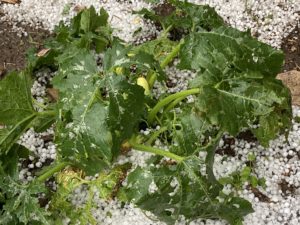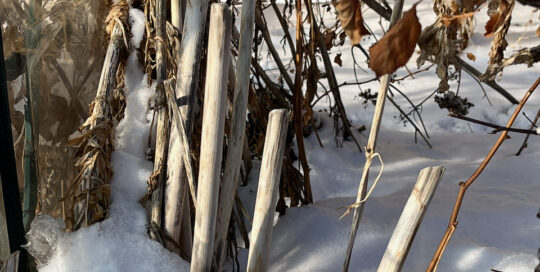Handling a Hail Storm
Views: 520

There’s nothing like watching the Angel of Death in the form of a hail storm approach your garden. That’s what happened to us the other evening. After a warm and lovely day, dark clouds rolled into the horizon. There was some lightning, lots of wind, torrential rain… and then the hail hit. After maybe 10 minutes of M&M sized hail stones, it was time to assess the damage.
Can anything be done about an incoming hail storm?
When the storm hit, I recorded it on Facebook Live. Thankfully, a friend on the other side of town saw it and covered her garden. Having a little warning goes a long way. If you can cover plants with floating row covers, sheets, blankets, or boxes it will do a lot to protect them. One year, I even opened up folding tables over the prized ‘Itoh’ peony and early lilies to fend off obliteration.
If you have container gardens, you’re in much better shape. Bring them inside the garage, home, or shed. At the very least, you can pull them to an area out of the worst of the weather.
Container Vegetable Garden that can Feed You for a Year
What happens when there isn’t enough time?
If you don’t receive fair warning, or don’t heed it, the only thing you can really do is watch until the mayhem ends. We didn’t expect hail at all. Honestly, we didn’t even count on rain. As we watched the storm hit full force, the smell of cilantro filled the air. Of course, anyone who has ever grown cilantro knows that it won’t be permanently harmed with a little hailstorm. It takes way more to knock out that stuff.
After it stopped, it was the typical assessment of the garden, picking up handfuls of hail in amazement. Even though we smelled the cilantro, it didn’t appear to be seriously damaged. The lanky tomatillos looked a bit battered. The beans were shredded, but my squash probably took the brunt of it with those big leaves. The kale, cabbage, and kohlrabi didn’t seem phased except for a few extra holes.
The greatest damage the hail does is reduce the ability of the plants to produce food through photosynthesis. When their leaves are damaged so is the means of sugar production. The good news, at least with this storm, is we might have holes, but we still have leaves.
After the hail storm
Even though some of the plants look pretty tattered, the good news is they will rebound. It’s not as if the plants were loaded with fruits and just about ready to harvest. Here in Montana, we are just hitting our stride as far as growth goes. Some nights are still in the 40s, but they are becoming warmer.
I’ll give everything a good feeding since the rain washed a lot away. Keep in mind that even when using a time-released fertilizer, if the rain is very intense and floods the area (or container), it might need a little more. The plants will do best if they are supported at this level.
A hail storm is discouraging. But it’s not the end of the garden. This is the time to pick up the pieces, maybe stake a couple of plants, and do what you can to encourage them to keep growing.
Meet Amy Grisak
Amy is a freelance author and photographer in Great Falls, MT who specializes in gardening, foods, and sustainable agriculture. She provides information on every kind…
Amy's Recent Posts

This Little Piggy is a Problem: Dealing with Feral Hogs








